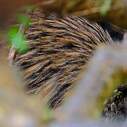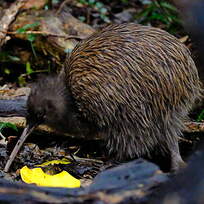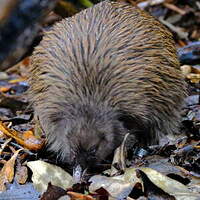Southern Brown Kiwi
Apteryx australis - Kiwi austral
Identification
This strange bird is flightless as its wings are reduced to stumps, although they still sport 13 remiges. Its plumage is quite peculiar, resembling coarse hair. The birds have no tail and their legs are short an robust, partially covered with scales. The bill is long and slightly curve downwards: the upper part, slightly longer than the lower part bears the nostrils at its end. The base of the beak is covered in sensory whiskers - stiff, unbarbed feathers.
Subspecific information 2 subspecies
- Apteryx australis australis (sw South I.)
- Apteryx australis lawryi (Stewart I.)
Foreign names
- Kiwi austral,
- Kiwi sureño,
- kiwi-do-sul,
- Südstreifenkiwi,
- barna kivi,
- Zuidelijke Bruine Kiwi,
- Kiwi bruno meridionale,
- sydkivi,
- Sørbrunkivi,
- kivi južný,
- kivi jižní,
- Brun Kiwi,
- eteläsaarenruskokiivi,
- kiwi bru de l'illa Sud,
- kiwi brunatny,
- Бурый киви,
- キーウィ,
- 褐几维,
- 南方褐鷸鴕,
Habitat
Behaviour character trait
Kiwis are notoriously hard to observe in the wild: they are extremely discreet and they are mostly nocturnal.
There is a way of spotting it however: the male's piercing whistling call ("ki-wi") to which female echo with a hoarse and creaking cry that resembles the noise one gets when opening a rusty stable door. These calls allow pairs to mark their territory and to maintain contact when they are foraging separately. Both partner also emit an assortment on grunts and whistles. Kiwis snort often while foraging for food. These snort are very audible and are due to the closing an opening of a valve just behind the nostrils which prevents them from inhaling debris and dust while searching the forest floor.Most birds use their eyesight and have a very feeble sense of smell. Kiwis contradict this tendency and it is estimated that they cannot see much beyond 60 cm by day and 2 meters by night. The unique placement of the nostrils a the tip of the bill means that kiwi smell rather than sight their prey and sensory feathers at the base of the bill aid navigation and compensate for the poor eyesight.
Dietfeeding habits
Head down, the kiwi forages in the forest litter in search of insects and small invertebrates: myriapoda, larvae, unearthing them with its beak. It seems that the kiwi uses is very developed hearing (kiwis have very large hearing orifices) to pinpoint their prey. It will also eat spiders, snails and numerous orthoptera. During the drier months, kiwis will happily become vegetarians.
Reproduction nesting
The Kiwi is thought to be monogamous. Once paired, the male builds a rudimentary nest on the ground. The egg is a luminous white and is abnormally big compared to the female: it can represent up to 14% of the adult's body mass (some 435 g). Incubation lasts 84 days and is done by the male, which only leaves the nest to forage for food. Newborn chicks have a uniformly brown down, the same colour as the adults.
Threats - protection
Sources of information
- IOC World Bird List (v14.2), Gill, F and D Donsker (Eds). 2024-04-18.
Other sources of interest
- Accipitriformes
- Aegotheliformes
- Anseriformes
- Apodiformes
- Apterygiformes
- Bucerotiformes
- Caprimulgiformes
- Cariamiformes
- Casuariiformes
- Charadriiformes
- Ciconiiformes
- Coliiformes
- Columbiformes
- Coraciiformes
- Cuculiformes
- Eurypygiformes
- Falconiformes
- Galliformes
- Gaviiformes
- Gruiformes
- Leptosomiformes
- Mesitornithiformes
- Musophagiformes
- Nyctibiiformes
- Opisthocomiformes
- Otidiformes
- Passeriformes
- Pelecaniformes
- Phaethontiformes
- Phoenicopteriformes
- Piciformes
- Podargiformes
- Podicipediformes
- Procellariiformes
- Psittaciformes
- Pterocliformes
- Rheiformes
- Sphenisciformes
- Steatornithiformes
- Strigiformes
- Struthioniformes
- Suliformes
- Tinamiformes
- Trogoniformes














